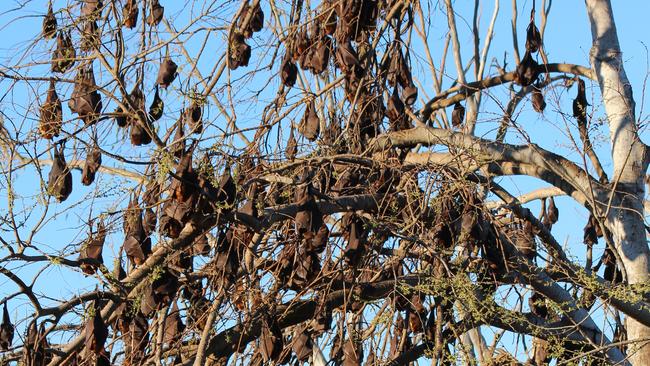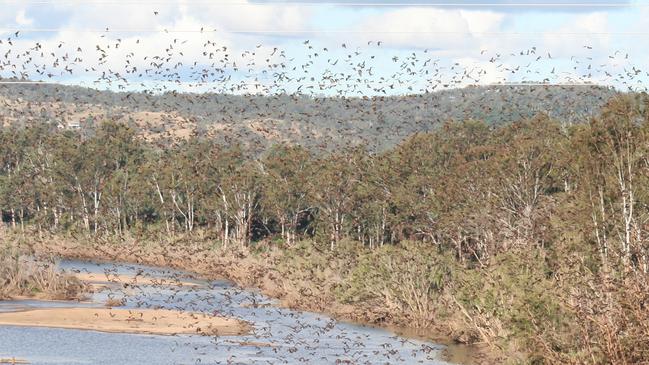North Burnett petition ask govt to expand flying fox management methods
A petition has been launched pleading with lawmakers to change the laws around what residents living beneath flying fox roosts are allowed to do to deal with the situation.

Central & North Burnett
Don't miss out on the headlines from Central & North Burnett. Followed categories will be added to My News.
A North Burnett woman has launched an epetition with the state government begging lawmakers to change environmental legislation to allow for more flexible methods when dealing with “plagues” of flying foxes.
Mundubbera resident Loris Doessel created a petition with the Queensland Parliament asking politicians to amend the Flying Fox Roost Management Framework to allow people living near roosts more options in dealing with colonies.
“Queensland residents draw to the attention of the House the increasing population and invasion of Little Red Flying Foxes into residential areas throughout Queensland,” the petition read.
“Your petitioners, therefore, request the House to urgently amend the Queensland Flying Fox Roost Management Framework to ensure residents are able to repel flying fox plagues using realistic and feasible methods to preserve the health, well-being and peace of mind of our community’s residents.”
At the time of publishing, the petition had more than 700 signatures.
The impact of flying fox colonies on some Burnett residents has been an issue for years, with previous roosts recording thousands of animals in one area.
In 2019, the North Burnett Regional Council reported the arrival of more than 80,000 little red flying foxes around Mundubbera and 30,000 in Eidsvold; other years the numbers have been as low as 2000 animals per colony.
According to the Queensland government’s list of known flying fox roosts, there are 12 confirmed sites in the North Burnett, which include three roosts in and around Mundubbera the Jones’ Weir, Billabong Motor Inn and Mundubbera Sawmill.
Comparatively, there are four known roosts in the South Burnett.
These include Taromeo Creek in Blackbutt, Proston Vine Scrub, Douglass Street in Murgon, and Mt Wooloorin Reserve in Kingaroy.

Flying foxes are protected under the Queensland government’s Nature Conservation Act 1992, which limits management activities to non-lethal methods and prohibits methods that could injure the animals, like using high pressure hoses and paintball guns.
Recommended methods to manage roost are trimming trees at night after flying foxes have left the roost or before they migrate into the area, installing floodlights, and making a “small smoke fire” between 3-7am which deter the animals from settling.
These techniques can help to prevent flying foxes from roosting in nearby trees, however they must be done during hours the animals are not already roosting.
A 2021 research review of the success of roost dispersal across the country indicated there were more than 100,000 flying foxes in Gayndah before dispersal attempts were run from 2011-2013.
There was no data to indicate the number of animals that still migrated to that area in the following years, and while there was evidence colonies moved away from the initial roost areas, they didn’t move far.
The study found the dispersal methods of “continuous noise” and “extensive vegetation removal” did successfully move the animals away from one location, but they “shifted along (the) river, (and were) still in town”.

In fact, the majority of roosts in the study that were able to be successfully dispersed reformed a new roost within 1km of the original site.
“It was not possible to nominate or predict the location of these new persistent replacement camps and 88 per cent (22 of 25) formed in locations that generated complaints from newly affected neighbours,” the study read.
At the March South Burnett Regional Council meeting, several councillors called on state MPs to step in and witness the first-hand impact of flying foxes on the local community.
Councillor Heath Sander said he believed the relevant minister needed to visit the area and see for themselves what impact the bats had on long suffering residents.
“I wouldn’t like living there myself and the people who make the rules need to see what’s actually going on on the ground and they might adjust their rules a little bit,” he said.
The petition can be found here and will close on August 24, 2025.





